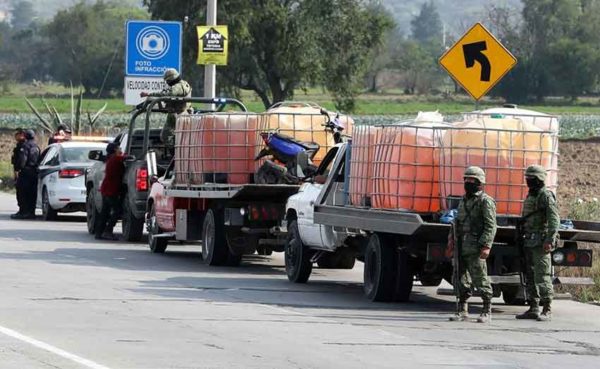Petroleum market is bigger, closer; ‘we all consume gasoline’
by Mexico News Daily
Mexico’s notorious cartels are not just hooked on drugs but fuel as well, according to a report published yesterday by the news agency Reuters.
Fuel theft from refineries and pipelines owned and operated by state oil company Pemex is rapidly becoming one of the biggest and most pressing economic and security concerns for Mexico, the report said.
It costs the federal government more than US $1 billion annually in lost revenue and is deterring foreign investment.
It’s a lucrative illicit market, and one that cartels splintered by the capture of narco kingpins and internal power struggles have increasingly sought to tap in their search for alternative revenue sources.
With an increasingly dominant role as fuel thieves, or huachicoleros as they are colloquially known, two of Mexico’s largest and most powerful industries — oil and narcotics — are now facing off, head to head.
Extortion and violence are commonly used by cartels against Pemex employees to gain access to or information about fuel sources. By directly targeting refineries rather than pipelines, cartels can access huge quantities of the nation’s fuel supply.
Those who comply with cartel demands can make massive personal gains. But for those who refuse to play along, the story can be quite different.
Reuters spoke to one former oil refinery employee from Salamanca, Guanajuato, who fled to Canada because he feared for his life after receiving death threats and being a victim of both kidnapping and violence.
“They said they knew who I was and where I lived,” Alberto Arredondo said, talking about the first time that someone claiming to be from the Familia Michoacána cartel called him in 2015. “They wanted information.”
After receiving a death threat in a subsequent call, he gave in and offered the information that the cartel sought.
In another incident in 2016, Arredondo was forced into a van and driven to a ranch where, under duress, he again offered the information that cartel operatives wanted. Later, they dumped him at the side of a road.
In yet another incident later the same year, Arredondo was stabbed in a bar. After recovering, he bought a plane ticket for Canada and left Mexico. “I knew that this was never going to end,” he said.
In 2016, Pemex reported revenue of about US $52 billion, meaning that the petroleum industry is one of just a few industries that is more profitable than the massive drug trade, which the Mexican government estimates at over US $21 billion annually.
Therein lies a big part of the attraction.
“The business is more profitable than drug trafficking because it implies less risk,” said Institutional Revolutionary Party (PRI) Deputy Georgina Trujillo.
The potential market is bigger and closer as well.
“You don’t have to risk crossing the border to look for a market. We all consume gasoline. We don’t all consume drugs,” Trujillo explained.
And that large demand is increasingly being met by illicit vendors on the black market.
Between 2011 and 2016, illegal pipeline taps went up almost fivefold, according to a recent Federal Auditor’s Office (ASF) report.
Pipeline repairs surged tenfold in the same period, costing almost 1.8 billion pesos (US $95 million).
When added to poor maintenance of their infrastructure, the problem results in the nation’s refineries losing massive amounts of fuel and money.
Considered collectively, “the refineries have accumulated annual operating losses of about [US] $5 billion in recent years,” Reuters said.
A 2014 energy reform promoted by current President Enrique Peña Nieto opened up the energy market to private and foreign companies but it also pushed fuel prices up because the government started to phase out subsidies to lure outside investment.
But the higher fuel prices also attracted criminals who were able to undercut retailers because their fuel didn’t cost than anything more than their time and effort to get it.
The stolen fuel market was more lucrative than ever and more and more criminal organizations wanted in.
But violence surged as well.
One example is Salamanca, Guanajuato, where a third of all new fuel taps in Mexico were discovered in 2016.
The dead bodies of refinery workers, police and suspected huachicoleros have become increasingly common sights around the city as have narcomantas, or narco signs, on which cartels mark their territory or make threats to rival gangs.
Guanajuato’s homicide rate last year rose by 14 percent on 2016 figures but represented a 71 percent increase on 2013 numbers.
One huachicolero recruited to a gang that now dominates the illegal fuel market in Salamanca told Reuters that he had killed about 30 people belonging to rival gangs that had tried to make incursions into their territory.
The man — known only as Juan — said the intruders included some of Mexico’s most notorious cartels such as the Zetas and the Caballeros Templarios.
Victims were usually buried in mass graves in a region the gang referred to as the “Bermuda Triangle,” Juan said.
The alleged leader of the criminal group known as the Santa Rosa de Lima Cartel, José Antonio Yepez, is wanted by federal authorities.
The man also known as “El Marro” or “The Mallet,” allegedly built up a payroll that included politicians, municipal, state and federal police as well as state and federal prosecutors.
Yepez also reportedly asked a local band to write corridos, or songs, about him, a common practice among powerful drug lords.
Having powerful people on his payroll ultimately paid off.
After being surrounded by security authorities in 2014, Juan told Reuters that Yepez made a quick phone call before police promptly allowed him and his accomplices to go.
Source: Reuters (en).



